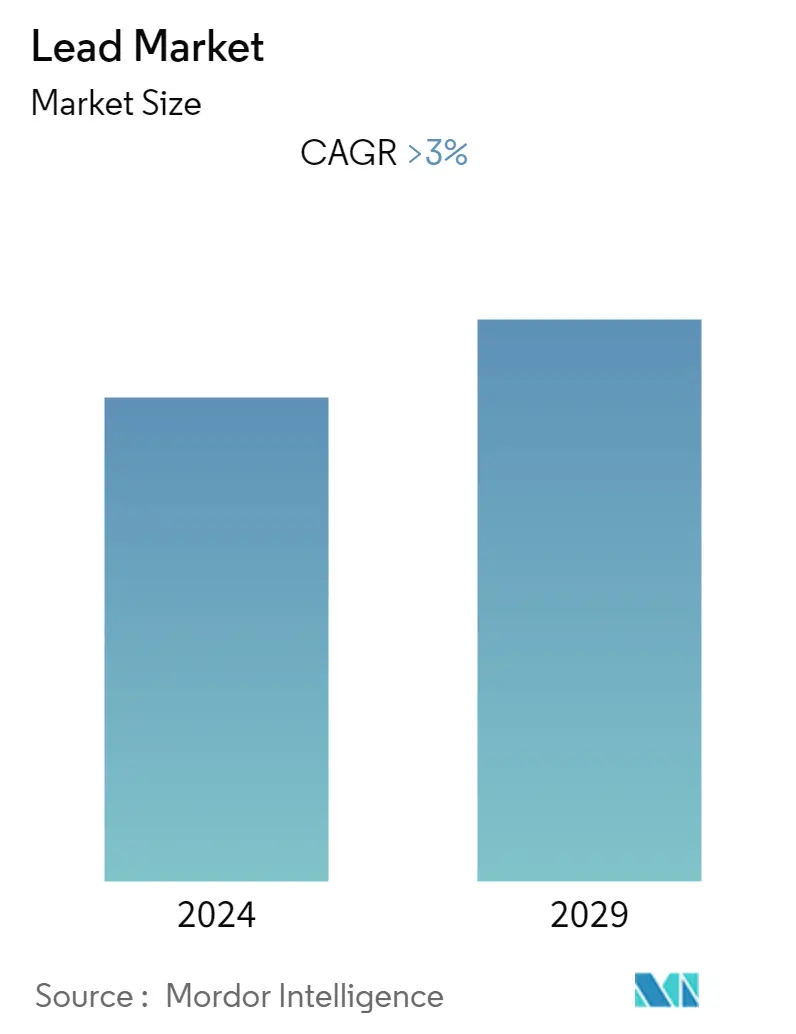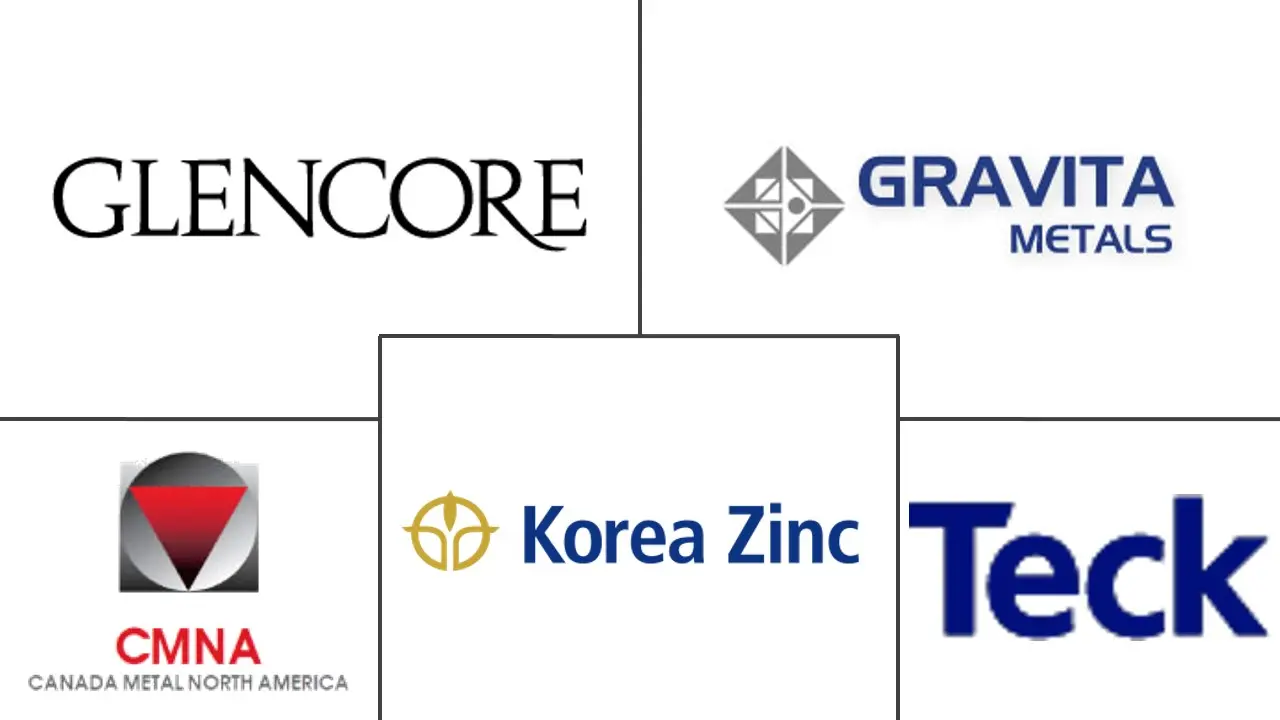Market Size of Lead Industry

| Study Period | 2019 - 2029 |
| Base Year For Estimation | 2023 |
| CAGR | > 3.00 % |
| Fastest Growing Market | Asia Pacific |
| Largest Market | Asia Pacific |
| Market Concentration | Low |
Major Players
*Disclaimer: Major Players sorted in no particular order |
Lead Market Analysis
The lead market is estimated at 10.32 million tons currently and is expected to reach 12.21 million tons over the forecast period, registering a CAGR of over 3% during the forecast period.
The market was negatively impacted by COVID-19 in 2020. Considering the pandemic scenario, construction activities and automotive production were stopped temporarily during the lockdown to curb the spread of new COVID-19 cases, thereby decreasing the demand for lead-based products such as lead batteries, lead sheets, lead-clad steel, and others from the industries. However, the market gained momentum in 2022 and is expected to grow in the forecast period.
- Over the short term, the growing demand for lead-acid batteries in electric vehicles is expected to drive market growth.
- On the flip side, the increasing adoption of lithium-ion batteries and other substitutes is expected to hinder the market's growth.
- The increasing number of solar power projects acts as an opportunity for the lead market to grow soon.
- Asia-Pacific is expected to dominate the global lead consumption, with most of the demand coming from China, South Korea, Japan, and other countries.
Lead Industry Segmentation
Lead is a soft, dull, malleable chemical element with the symbol Pb, which can be derived from mined ores such as lead sulfide (PbS) galena, cerussite (lead carbonate), anglesite (lead sulfate), and scraps, including batteries, pipes, etc. Lead finds its major application in lead-acid batteries, followed by pigments, ammunition, cable sheathing, and others. The lead market is segmented by application and geography. The market is segmented by application into ammunition, batteries, construction, electronics, marine, plumbing, and other applications. The report also covers the market sizes and forecasts for the lead market in 15 countries across the major regions. For each segment, the market sizing and forecasts have been done based on volume (tons).
| Application | |
| Ammunition | |
| Batteries | |
| Construction | |
| Electronics | |
| Marine | |
| Plumbing | |
| Other Applications |
| Geography | ||||||||||||||||||||||||||||||||
| ||||||||||||||||||||||||||||||||
|
Lead Market Size Summary
The lead market is poised for growth, driven by the increasing demand for lead-acid batteries, particularly in the electric vehicle sector. Despite the initial setbacks due to the COVID-19 pandemic, which temporarily halted construction and automotive production, the market has rebounded and is expected to continue its upward trajectory. The demand for lead is primarily fueled by its extensive use in batteries, which are essential for motor vehicles and renewable energy storage systems. However, the market faces challenges from the rising adoption of lithium-ion batteries and other alternatives. Opportunities for growth are also present in the expanding solar power projects, which require reliable energy storage solutions.
Asia-Pacific is anticipated to lead global lead consumption, with significant contributions from countries like China, Japan, and India. The region's dominance is supported by the burgeoning electric vehicle market, particularly in China, where government initiatives and affordable vehicle models are boosting demand. The construction industry in Asia-Pacific, especially in China and Japan, further supports lead consumption through its use in various construction materials. The market is characterized by a fragmented landscape with key players such as Glencore, KOREAZINC, and Teck Resources Limited, among others, competing for market share. These dynamics indicate a competitive environment with potential for continued growth in the lead market.
Lead Market Size - Table of Contents
-
1. MARKET DYNAMICS
-
1.1 Drivers
-
1.1.1 Rising Demand for Lead-Acid Batteries in Electric Vehicles
-
1.1.2 Other Drivers
-
-
1.2 Restraints
-
1.2.1 Increasing Adoption of Lithium-Ion Batteries and Other Substitutes
-
1.2.2 Other Restraints
-
-
1.3 Industry Value Chain Analysis
-
1.4 Porter's Five Forces Analysis
-
1.4.1 Threat of New Entrants
-
1.4.2 Bargaining Power of Buyers
-
1.4.3 Bargaining Power of Suppliers
-
1.4.4 Threat of Substitute Products
-
1.4.5 Degree of Competition
-
-
-
2. MARKET SEGMENTATION (Market Size in Volume)
-
2.1 Application
-
2.1.1 Ammunition
-
2.1.2 Batteries
-
2.1.3 Construction
-
2.1.4 Electronics
-
2.1.5 Marine
-
2.1.6 Plumbing
-
2.1.7 Other Applications
-
-
2.2 Geography
-
2.2.1 Production Analysis
-
2.2.1.1 Australia
-
2.2.1.2 Bolivia
-
2.2.1.3 China
-
2.2.1.4 India
-
2.2.1.5 Kazakhstan
-
2.2.1.6 Mexico
-
2.2.1.7 Peru
-
2.2.1.8 Russia
-
2.2.1.9 Sweden
-
2.2.1.10 Turkey
-
2.2.1.11 United States
-
-
2.2.2 Consumption Analysis
-
2.2.2.1 Asia-Pacific
-
2.2.2.1.1 China
-
2.2.2.1.2 India
-
2.2.2.1.3 Japan
-
2.2.2.1.4 South Korea
-
2.2.2.1.5 ASEAN Countries
-
2.2.2.1.6 Rest of Asia-Pacific
-
-
2.2.2.2 North America
-
2.2.2.2.1 United States
-
2.2.2.2.2 Canada
-
2.2.2.2.3 Mexico
-
-
2.2.2.3 Europe
-
2.2.2.3.1 Germany
-
2.2.2.3.2 United Kingdom
-
2.2.2.3.3 France
-
2.2.2.3.4 Italy
-
2.2.2.3.5 Rest of Europe
-
-
2.2.2.4 South America
-
2.2.2.4.1 Brazil
-
2.2.2.4.2 Argentina
-
2.2.2.4.3 Rest of South America
-
-
2.2.2.5 Middle East and Africa
-
2.2.2.5.1 Qatar
-
2.2.2.5.2 South Africa
-
2.2.2.5.3 Rest of Middle East and Africa
-
-
-
-
Lead Market Size FAQs
What is the current Lead Market size?
The Lead Market is projected to register a CAGR of greater than 3% during the forecast period (2024-2029)
Who are the key players in Lead Market?
Canada Metal North America Ltd, Glencore, Gravita India Ltd, KOREAZINC and Teck Resources Limited are the major companies operating in the Lead Market.

